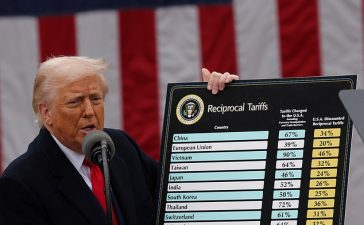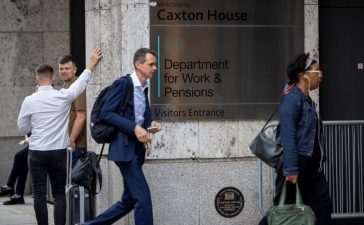This article is an on-site version of our Unhedged newsletter. Sign up here to get the newsletter sent straight to your inbox every weekday
Good morning. Nvidia keeps powering higher, but it’s not the only thing stoking bubble talk. Non-fungible pixel art is selling for eight-figure sums again, MicroStrategy is borrowing $600mn to buy more bitcoin and dogecoin’s price has doubled in a week. Scariest of all, Nouriel Roubini, who puts the perma in perma-bear, is bullish now. Be careful out there, and email us: robert.armstrong@ft.com and ethan.wu@ft.com.
A frozen spring for US housing
The US economy continues to beat expectations and risk assets are doing great. Or, rather, almost all risk assets are doing great, depending on whether you consider your house a risk asset. I do, at my low moments, and house prices have been going sideways. Below is the Case-Shiller price index. It has shown positive year-over-year growth since last summer, but zooming out and looking at levels rather than rates, it is clear house prices have been rangebound for a couple of years, at the extraordinarily high level reached in the pandemic period:

The reason why this one corner of the market remains stubbornly frozen is, of course, that rates remain high. Here is the 30-year fixed rate mortgage:

To the degree the housing market showed little flashes of life in recent months, that was likely down to the brief moments in which mortgages fell towards 6.5 per cent. Mostly, the market is frozen. Existing home sales are stuck at an annualised rate of about 4mn. Here’s a chart from the National Association of Realtors:

The total sales number conceals variations at different price levels. Cheap home sales are falling, whereas expensive home sales are rising quickly. But in aggregate, the familiar problem still holds. No one is selling who doesn’t have to sell; everyone wants to keep their cheap mortgages. For-sale inventory remains very low, with less than a million existing homes available:

This problem is not set to get better soon. A growing economy, a tight labour market and signs that core inflation has stopped falling or might even be picking up mean the Federal Reserve is in no hurry to cut rates.
The new home market, which is in better shape, provides only limited relief. New single-family homes are selling at a rate of about 600,000 a year, and while new home construction is up, it is not hugely up. And as Ethan laid out back in September, while multifamily construction has been strong, it is not a perfect substitute for single-family homes for a variety of reasons. Rent growth may have cooled, but rent levels remain high.
In short, the housing market has been stuck, and it’s still stuck. How much does this matter? At the margins, investment in housing can be an important input to economic growth (all the more so because the assets involved tend to be leveraged, as anyone who was around 15 years ago will remember). And that investment has been soft. There has been enough activity to keep construction employment from being a drag on the economy, but that’s about it. Growth in real private residential fixed investment only just returned to zero:

Maybe when rates do finally fall (they are going to fall, right?), the economy will enjoy a burst of pent-up demand. As Don Rissmiller of Strategas put it to me: “There is a sense in which the housing market is not clearing, it wants to clear, and if lower rates give it a little nudge, you could see more activity.” But as Nancy Vanden Houten of Oxford Economics points out, it might take a pretty big move in rates to solve the supply problem, given that the average homeowner’s mortgage rate is far below the market rate.
A more likely possibility, given the current economic set-up, is that housing remains an oasis of sluggishness in an otherwise strong economy, and most American families are stuck paying high rents and gazing through brokers’ windows at unaffordable houses. This goes some way to explaining why consumer sentiment remains so poor.
The future of QT
Yesterday, we wrote about how quantitative tightening has gone so far. But the QT experiment is far from over, and today we turn to QT’s future, in particular to two speeches last Friday from influential Fed officials. Lorie Logan, Dallas Fed president, is the central bank’s former top portfolio manager; her pronouncements on balance sheet policy carry weight. Fed governor Christopher Waller has been a leading indicator of Fed thinking; there is chatter he may be the next Fed chair. Read together, their speeches highlight three questions around QT, and the differences of opinion that may soon emerge at the central bank.
Pace: how fast should QT proceed? Most Fed members agree on the goal: the balance sheet, at 28 per cent of nominal GDP, is still too big and should keep shrinking. Where officials disagree is how best to get there. Logan has argued that a slower pace of balance sheet run-off would ultimately lead to a smaller balance sheet. Waller supports “support[s] further thinking” on the pace, but appears less sure of the need to go slow. He notes that the $440bn still parked at the reverse repo window represents “excess liquidity that financial market participants do not want”, suggesting that “we can continue to reduce our holdings for some time”.
End date: when should QT stop? The Fed wants to maintain a regime of “ample” commercial bank reserves, as opposed to the regime of “scarce” reserves in place before the financial crisis. But just when “ample” reserves turn into “scarce”, in terms of balance sheet size, is unclear. There is always the risk of going too far and creating a funding market accident, as in the 2019 repo market crisis.
Logan is focused on what funding markets are telling us, in particular on the spread between money market rates and what the Fed pays on commercial bank reserves (called the interest rate on reserve balances, or IORB). Right now, that spread is tiny. But in principle, when money market fund (MMF) rates are noticeably above IORB, it indicates that MMFs have to pay up to attract cash — liquidity is too scarce. In sum, stop QT once funding markets start screaming “scarce!”.
Waller takes a more top-down approach, looking at where reserves are distributed across the financial system. He puts special weight on the safeguards the Fed has installed around funding markets, including the standing repo facility, which lets banks borrow short-term cash against their Treasuries. The SRF did not exist during the 2019 repo crisis, and has probably changed money-market dynamics. Waller notes that the SRF “may allow banks to lower the level of reserves below” what might otherwise be possible, providing “a signal for when reserves are getting close to ample”. In other words, we’ll know when it’s time to wrap up QT by how many banks come knocking at the Fed’s door.
Composition: which assets stay on the Fed’s balance sheet? Most Fed officials support reducing the central bank’s mortgage-backed securities holdings to zero, to avoid distorting the mortgage market. More interestingly, Waller argues for having a greater share of short-term Treasury bills on the balance sheet. The share of bills fell drastically after the financial crisis, from about a third of the balance sheet to nearly zero, as the Fed hoovered up long-term bonds. It now sits at about 5 per cent.
Waller cites two reasons for liking a bigger balance of bills. First, it would help mitigate the unseemly accounting losses the Fed has racked up as rates rise, since bills are much less rate-sensitive. Second, it could let the central bank conduct future rounds of QE without expanding the balance sheet. The Fed would buy Treasury bonds to push down long-term interest rates while letting short-term bills roll off the balance sheet.
Joseph Wang at the Fed Guy blog pointed out to us that Waller’s vision would represent the Fed pulling apart two functions of balance sheet policy. One is the reserves component: the central bank needs a big enough balance sheet to maintain ample reserves. Second is the asset market component: the Fed wants to target specific markets, for example stimulating lending by suppressing long-term Treasury yields. Having more bills on the balance sheet would let the Fed achieve the second goal without interfering with the first.
The central bank will begin having these debates at its meeting later this month. We’ll be watching how chair Jay Powell frames the argument in his press conference, where he speaks for the whole committee. There is enough ambiguity to keep the debate lively and Fed-watchers on edge. (Ethan Wu)
One good read
James Mackintosh argues against bubble talk.
FT Unhedged podcast

Can’t get enough of Unhedged? Listen to our new podcast, hosted by Ethan Wu and Katie Martin, for a 15-minute dive into the latest markets news and financial headlines, twice a week. Catch up on past editions of the newsletter here.










